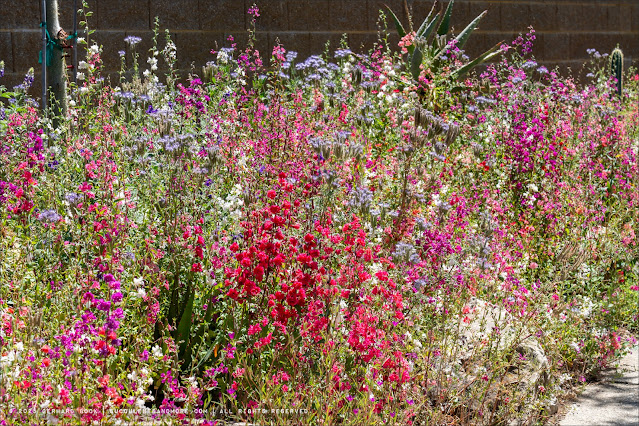I went to the Ruth Bancroft Garden (RBG) yesterday with a group of volunteers from the UC Davis Arboretum Teaching Nursery. The first thing I noticed was this wildflower meadow in the new bed along Bancroft Road. Poppies, phacelias, and all kinds of clarkias – all annuals native to California. I thought it looked fantastic paired with cacti, agaves, and the like.
As it turns out, this carpet of wildflowers was not created by the RBG staff. Brian Kemble, the curator of the RBG, told me that somebody seed-bombed this bed in the fall. That would be easy to do, seeing how it’s located next to the sidewalk, outside the garden wall. The result, while completely unexpected, was very much appreciated. Brian said that they would let the flowers go to seed in hopes of a repeat performance next year.
Seed bombing is a classic form of guerrilla gardening. Check out
this article; I had no idea there were that many different kinds of seed bombs!
I wonder if the person responsible for the wildflower display at the RBG will ever come forward. Probably not. In any case, I was happy to see the result. It put a smile on everybody’s face.
Since I was with a group of people, I didn’t take as many photos at the garden as usual. Here are a few snaps of flowering perennials that looked great among the rocks.
 |
| Guessing this is sulfur buckwheat (Eriogonum umbellatum) |
 |
| Lavender cotton (Santolina incana) |
 |
| Plains zinnia (Zinnia grandiflora) |
 |
| Capraian cornflower (Centaurea gymnocarpa) |
 |
| And the biggest surprise of all, one of several clumps of Dianthus. I will admit I’d written off dianthus as one of “those” plants (you know, pansies, petunias, etc.). As it turns out, dianthus is tough and drought-tolerant once established, making it a great companion plant for succulents. |
 |
| The pincushions (Leucospermum) were in glorious flower all over the garden. This is Leucospermum reflexum. |
 |
| Dudleya brittonii with three inflorescences |
 |
| Buckwheat starting to flower in the California native section. I have no idea what species it is, and I won’t try to guess. |
 |
| Athanasia pinnata, a wonderfully fluffy shrub from South Africa, in front of a huge Agave franzosinii |
 |
| One of several puyas in flower |
 |
| The flowers of this puya hybrid are remarkable: they start out a purplish blue, contrasting beautifully with the yellow pollen, then fade to a dark magenta |
I was going to limit this post to flowers, but it’s simply not possible for me to ignore my favorite agaves:
 |
| Agave victoriae-reginae, absolutely perfect |
 |
| Agave nickelsiae, just as perfect |
 |
| Another Agave nickelsiae in the early stages of flowering. Check out the comically tall, skinny inflorescence! Brian Kemble and a few members of our group for scale. |
More “regular” photos of the RBG the next time I visit.
© Gerhard Bock, 2025. All rights reserved. To receive all new posts by email, please subscribe here.



















What I find most interesting about the seed bombing is that the horticultural staff embraced it wholeheartedly. After all, it's not like the guerrilla-sown flowers starting blooming out of nowhere, impressing everyone with their beauty. The staff would have seen the seedlings coming up weeks or months ago and made the decision to let them grow -- perhaps without knowing exactly what they were going to be. Unless this was an inside job (ha!), it seems to be a uniquely cooperative instance of community gardening at a highly planned public garden.
ReplyDeleteThe flowers more purposely situated among the agaves are more appealing to me. Although I love all kinds of flowers, the seed bombed bed is more chaotic than I like, which is not to say I wouldn't like to do something like that to the weedy empty lot up the street from me ;)
ReplyDelete